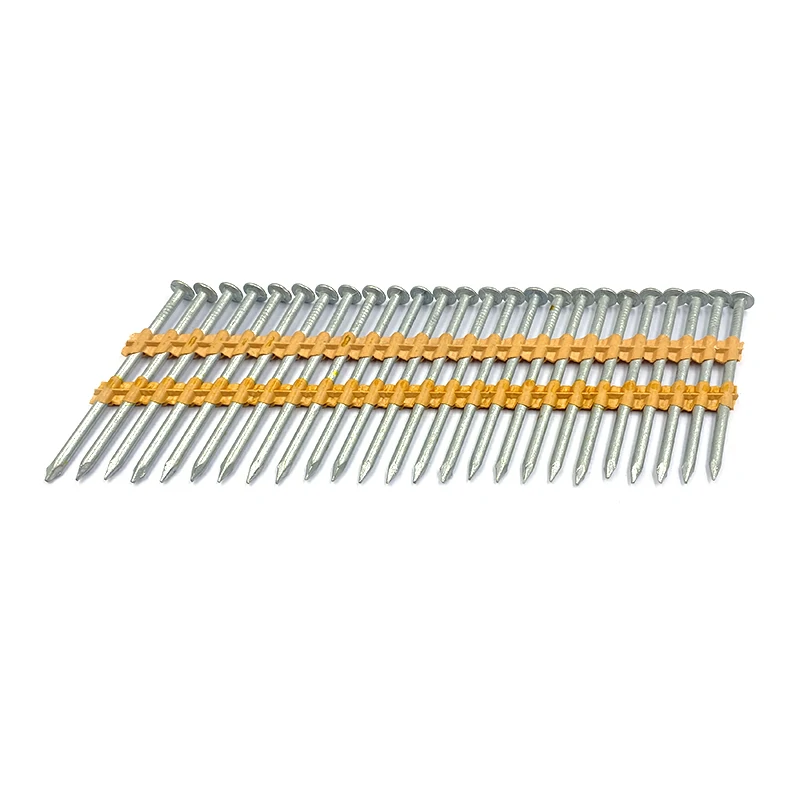A 21-degree nail refers to a type of framing nail that is commonly used in construction and carpentry applications. The “21-degree” refers to the angle at which the nail is collated or arranged in a strip or coil for use with a pneumatic nail gun or nailer.
Here are some key details about 21-degree nails:
- Nail Angle: The 21-degree angle refers to the slant or tilt of the nail strip in relation to the nail’s shank. This angle is specifically designed to fit into the magazine of a 21-degree framing nailer, which is a popular type of nail gun used for heavy-duty framing and construction projects.
- Nail Size: The specific size of 21-degree nails can vary depending on the manufacturer and the intended application. They are typically available in lengths ranging from 2 inches to 3-1/2 inches (5 cm to 9 cm). The diameter or gauge of the nail can also vary, with common options being 8-gauge or 10-gauge.
- Framing Applications: 21-degree nails are primarily used in framing applications, such as building houses, installing structural components, or constructing wooden frameworks. They are suitable for fastening large pieces of lumber, beams, trusses, and other heavy-duty framing materials.
- Collation: 21-degree nails are collated in either plastic strips or wire-coil configurations. The collation method determines the way the nails are held together and fed into the nail gun. The collation type of the nails should match the requirements of the specific nail gun being used.
- Pneumatic Nail Gun: 21-degree nails are commonly used with pneumatic nail guns or nailers that are designed to accommodate this specific collation angle. These nail guns use compressed air to drive the nails into the material efficiently and quickly, making them popular among professional carpenters and contractors.
- Versatility: While 21-degree nails are primarily used in framing applications, they can also be suitable for other tasks that require strong and durable fastening, such as attaching subflooring, sheathing, or decking.
It’s important to note that the specific requirements for nails may vary depending on the project and local building codes. Always consult with professionals or adhere to the manufacturer’s recommendations for the appropriate nail size, angle, 21 degree nails and collation type for your specific construction or carpentry project.
What the 21-degree nail is for ?
Here are some additional details about 21-degree nails:
- Nail Head: 21-degree nails typically have a clipped or offset round head. The head design helps to provide a larger bearing surface and improved holding power when fastening materials together. The clipped head also allows for more nails to be loaded into the nail gun’s magazine, reducing the frequency of reloading.
- Shank Design: The shank of a 21-degree nail refers to the body or shaft of the nail. It is usually smooth or slightly textured to facilitate easy penetration into the material being fastened. The shank may also have ring or spiral threads near the tip to enhance the nail’s grip and holding power.
- Galvanized or Coated Options: 21-degree nails are commonly available in galvanized or coated versions. Galvanized nails are coated with a layer of zinc, which provides corrosion resistance and helps prevent rusting when used in outdoor or high-moisture environments. Coated nails may have additional coatings, such as vinyl or epoxy, for improved durability and protection against corrosion.
- Application Guidelines: When using 21-degree nails, it’s important to follow the manufacturer’s guidelines and recommendations for the specific nail gun being used. This includes selecting the appropriate nail length, ensuring proper loading and feeding of the nails into the nail gun, and adjusting the nail gun’s depth settings for desired nail penetration.
- Safety Considerations: When working with 21-degree nails or any other type of nails, it’s important to observe safety precautions. Wear appropriate personal protective equipment, including safety glasses and gloves, to protect against flying debris. Follow the nail gun’s safety instructions and handle the tool responsibly to avoid accidents or injuries.
- Availability: 21-degree nails and the corresponding nail guns can typically be found at hardware stores, home improvement centers, or specialized suppliers. It’s recommended to consult with professionals or suppliers knowledgeable in construction or carpentry to ensure you select the appropriate nails for your specific project.
Remember, the use of 21-degree nails is primarily for framing and heavy-duty construction applications. For other types of projects or materials, different nail types or sizes may be more suitable. Consulting with professionals or experts in the field can provide further guidance and recommendations based on your specific needs.

